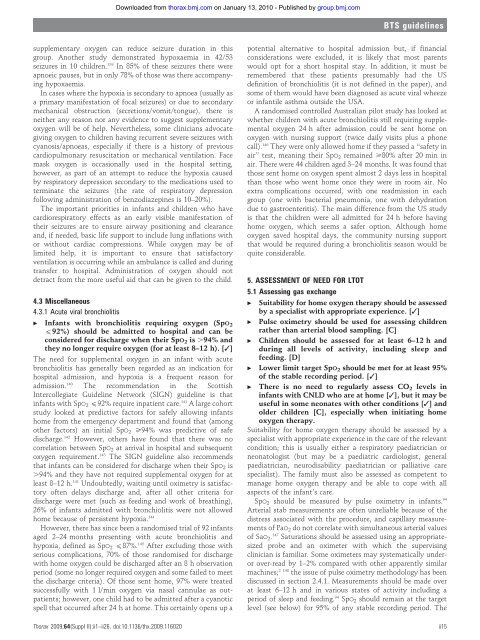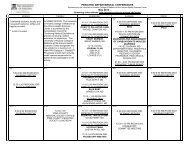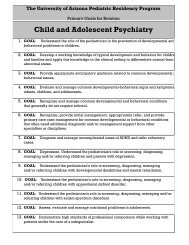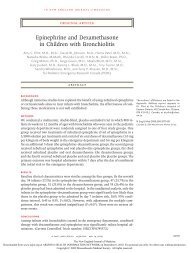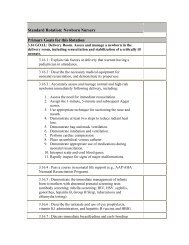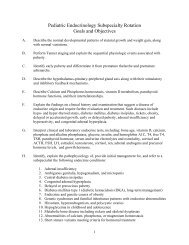BTS guidelines for home oxygen in children - University of Arizona ...
BTS guidelines for home oxygen in children - University of Arizona ...
BTS guidelines for home oxygen in children - University of Arizona ...
You also want an ePaper? Increase the reach of your titles
YUMPU automatically turns print PDFs into web optimized ePapers that Google loves.
Downloaded from thorax.bmj.com on January 13, 2010 - Published by group.bmj.com<br />
<strong>BTS</strong> <strong>guidel<strong>in</strong>es</strong><br />
supplementary <strong>oxygen</strong> can reduce seizure duration <strong>in</strong> this<br />
group. Another study demonstrated hypoxaemia <strong>in</strong> 42/53<br />
seizures <strong>in</strong> 10 <strong>children</strong>. 139 In 85% <strong>of</strong> these seizures there were<br />
apnoeic pauses, but <strong>in</strong> only 78% <strong>of</strong> those was there accompany<strong>in</strong>g<br />
hypoxaemia.<br />
In cases where the hypoxia is secondary to apnoea (usually as<br />
a primary manifestation <strong>of</strong> focal seizures) or due to secondary<br />
mechanical obstruction (secretions/vomit/tongue), there is<br />
neither any reason nor any evidence to suggest supplementary<br />
<strong>oxygen</strong> will be <strong>of</strong> help. Nevertheless, some cl<strong>in</strong>icians advocate<br />
giv<strong>in</strong>g <strong>oxygen</strong> to <strong>children</strong> hav<strong>in</strong>g recurrent severe seizures with<br />
cyanosis/apnoeas, especially if there is a history <strong>of</strong> previous<br />
cardiopulmonary resuscitation or mechanical ventilation. Face<br />
mask <strong>oxygen</strong> is occasionally used <strong>in</strong> the hospital sett<strong>in</strong>g,<br />
however, as part <strong>of</strong> an attempt to reduce the hypoxia caused<br />
by respiratory depression secondary to the medications used to<br />
term<strong>in</strong>ate the seizures (the rate <strong>of</strong> respiratory depression<br />
follow<strong>in</strong>g adm<strong>in</strong>istration <strong>of</strong> benzodiazep<strong>in</strong>es is 10–20%).<br />
The important priorities <strong>in</strong> <strong>in</strong>fants and <strong>children</strong> who have<br />
cardiorespiratory effects as an early visible manifestation <strong>of</strong><br />
their seizures are to ensure airway position<strong>in</strong>g and clearance<br />
and, if needed, basic life support to <strong>in</strong>clude lung <strong>in</strong>flations with<br />
or without cardiac compressions. While <strong>oxygen</strong> may be <strong>of</strong><br />
limited help, it is important to ensure that satisfactory<br />
ventilation is occurr<strong>in</strong>g while an ambulance is called and dur<strong>in</strong>g<br />
transfer to hospital. Adm<strong>in</strong>istration <strong>of</strong> <strong>oxygen</strong> should not<br />
detract from the more useful aid that can be given to the child.<br />
4.3 Miscellaneous<br />
4.3.1 Acute viral bronchiolitis<br />
c Infants with bronchiolitis requir<strong>in</strong>g <strong>oxygen</strong> (SpO 2<br />
(92%) should be admitted to hospital and can be<br />
considered <strong>for</strong> discharge when their SpO 2 is .94% and<br />
they no longer require <strong>oxygen</strong> (<strong>for</strong> at least 8–12 h). [3]<br />
The need <strong>for</strong> supplemental <strong>oxygen</strong> <strong>in</strong> an <strong>in</strong>fant with acute<br />
bronchiolitis has generally been regarded as an <strong>in</strong>dication <strong>for</strong><br />
hospital admission, and hypoxia is a frequent reason <strong>for</strong><br />
admission. 140 The recommendation <strong>in</strong> the Scottish<br />
Intercollegiate Guidel<strong>in</strong>e Network (SIGN) guidel<strong>in</strong>e is that<br />
<strong>in</strong>fants with SpO 2 (92% require <strong>in</strong>patient care. 141 A large cohort<br />
study looked at predictive factors <strong>for</strong> safely allow<strong>in</strong>g <strong>in</strong>fants<br />
<strong>home</strong> from the emergency department and found that (among<br />
other factors) an <strong>in</strong>itial SpO 2 >94% was predictive <strong>of</strong> safe<br />
discharge. 142 However, others have found that there was no<br />
correlation between SpO 2 at arrival <strong>in</strong> hospital and subsequent<br />
<strong>oxygen</strong> requirement. 143 The SIGN guidel<strong>in</strong>e also recommends<br />
that <strong>in</strong>fants can be considered <strong>for</strong> discharge when their SpO 2 is<br />
.94% and they have not required supplemental <strong>oxygen</strong> <strong>for</strong> at<br />
least 8–12 h. 141 Undoubtedly, wait<strong>in</strong>g until oximetry is satisfactory<br />
<strong>of</strong>ten delays discharge and, after all other criteria <strong>for</strong><br />
discharge were met (such as feed<strong>in</strong>g and work <strong>of</strong> breath<strong>in</strong>g),<br />
26% <strong>of</strong> <strong>in</strong>fants admitted with bronchiolitis were not allowed<br />
<strong>home</strong> because <strong>of</strong> persistent hypoxia. 144<br />
However, there has s<strong>in</strong>ce been a randomised trial <strong>of</strong> 92 <strong>in</strong>fants<br />
aged 2–24 months present<strong>in</strong>g with acute bronchiolitis and<br />
hypoxia, def<strong>in</strong>ed as SpO 2 (87%. 145 After exclud<strong>in</strong>g those with<br />
serious complications, 70% <strong>of</strong> those randomised <strong>for</strong> discharge<br />
with <strong>home</strong> <strong>oxygen</strong> could be discharged after an 8 h observation<br />
period (some no longer required <strong>oxygen</strong> and some failed to meet<br />
the discharge criteria). Of those sent <strong>home</strong>, 97% were treated<br />
successfully with 1 l/m<strong>in</strong> <strong>oxygen</strong> via nasal cannulae as outpatients;<br />
however, one child had to be admitted after a cyanotic<br />
spell that occurred after 24 h at <strong>home</strong>. This certa<strong>in</strong>ly opens up a<br />
Thorax 2009;64(Suppl II):ii1–ii26. doi:10.1136/thx.2009.116020<br />
potential alternative to hospital admission but, if f<strong>in</strong>ancial<br />
considerations were excluded, it is likely that most parents<br />
would opt <strong>for</strong> a short hospital stay. In addition, it must be<br />
remembered that these patients presumably had the US<br />
def<strong>in</strong>ition <strong>of</strong> bronchiolitis (it is not def<strong>in</strong>ed <strong>in</strong> the paper), and<br />
some <strong>of</strong> them would have been diagnosed as acute viral wheeze<br />
or <strong>in</strong>fantile asthma outside the USA.<br />
A randomised controlled Australian pilot study has looked at<br />
whether <strong>children</strong> with acute bronchiolitis still requir<strong>in</strong>g supplemental<br />
<strong>oxygen</strong> 24 h after admission could be sent <strong>home</strong> on<br />
<strong>oxygen</strong> with nurs<strong>in</strong>g support (twice daily visits plus a phone<br />
call). 146 They were only allowed <strong>home</strong> if they passed a ‘‘safety <strong>in</strong><br />
air’’ test, mean<strong>in</strong>g their SpO 2 rema<strong>in</strong>ed >80% after 20 m<strong>in</strong> <strong>in</strong><br />
air. There were 44 <strong>children</strong> aged 3–24 months. It was found that<br />
those sent <strong>home</strong> on <strong>oxygen</strong> spent almost 2 days less <strong>in</strong> hospital<br />
than those who went <strong>home</strong> once they were <strong>in</strong> room air. No<br />
extra complications occurred, with one readmission <strong>in</strong> each<br />
group (one with bacterial pneumonia, one with dehydration<br />
due to gastroenteritis). The ma<strong>in</strong> difference from the US study<br />
is that the <strong>children</strong> were all admitted <strong>for</strong> 24 h be<strong>for</strong>e hav<strong>in</strong>g<br />
<strong>home</strong> <strong>oxygen</strong>, which seems a safer option. Although <strong>home</strong><br />
<strong>oxygen</strong> saved hospital days, the community nurs<strong>in</strong>g support<br />
that would be required dur<strong>in</strong>g a bronchiolitis season would be<br />
quite considerable.<br />
5. ASSESSMENT OF NEED FOR LTOT<br />
5.1 Assess<strong>in</strong>g gas exchange<br />
c Suitability <strong>for</strong> <strong>home</strong> <strong>oxygen</strong> therapy should be assessed<br />
by a specialist with appropriate experience. [3]<br />
c Pulse oximetry should be used <strong>for</strong> assess<strong>in</strong>g <strong>children</strong><br />
rather than arterial blood sampl<strong>in</strong>g. [C]<br />
c Children should be assessed <strong>for</strong> at least 6–12 h and<br />
dur<strong>in</strong>g all levels <strong>of</strong> activity, <strong>in</strong>clud<strong>in</strong>g sleep and<br />
feed<strong>in</strong>g. [D]<br />
c Lower limit target SpO 2 should be met <strong>for</strong> at least 95%<br />
<strong>of</strong> the stable record<strong>in</strong>g period. [3]<br />
c There is no need to regularly assess CO 2 levels <strong>in</strong><br />
<strong>in</strong>fants with CNLD who are at <strong>home</strong> [3], but it may be<br />
useful <strong>in</strong> some neonates with other conditions [3] and<br />
older <strong>children</strong> [C], especially when <strong>in</strong>itiat<strong>in</strong>g <strong>home</strong><br />
<strong>oxygen</strong> therapy.<br />
Suitability <strong>for</strong> <strong>home</strong> <strong>oxygen</strong> therapy should be assessed by a<br />
specialist with appropriate experience <strong>in</strong> the care <strong>of</strong> the relevant<br />
condition; this is usually either a respiratory paediatrician or<br />
neonatologist (but may be a paediatric cardiologist, general<br />
paediatrician, neurodisability paediatrician or palliative care<br />
specialist). The family must also be assessed as competent to<br />
manage <strong>home</strong> <strong>oxygen</strong> therapy and be able to cope with all<br />
aspects <strong>of</strong> the <strong>in</strong>fant’s care.<br />
SpO 2 should be measured by pulse oximetry <strong>in</strong> <strong>in</strong>fants. 94<br />
Arterial stab measurements are <strong>of</strong>ten unreliable because <strong>of</strong> the<br />
distress associated with the procedure, and capillary measurements<br />
<strong>of</strong> PaO 2 do not correlate with simultaneous arterial values<br />
<strong>of</strong> SaO 2 . 147 Saturations should be assessed us<strong>in</strong>g an appropriatesized<br />
probe and an oximeter with which the supervis<strong>in</strong>g<br />
cl<strong>in</strong>ician is familiar. Some oximeters may systematically underor<br />
over-read by 1–2% compared with other apparently similar<br />
mach<strong>in</strong>es; 2 148 the issue <strong>of</strong> pulse oximetry methodology has been<br />
discussed <strong>in</strong> section 2.4.1. Measurements should be made over<br />
at least 6–12 h and <strong>in</strong> various states <strong>of</strong> activity <strong>in</strong>clud<strong>in</strong>g a<br />
period <strong>of</strong> sleep and feed<strong>in</strong>g. 94 SpO 2 should rema<strong>in</strong> at the target<br />
level (see below) <strong>for</strong> 95% <strong>of</strong> any stable record<strong>in</strong>g period. The<br />
ii15


